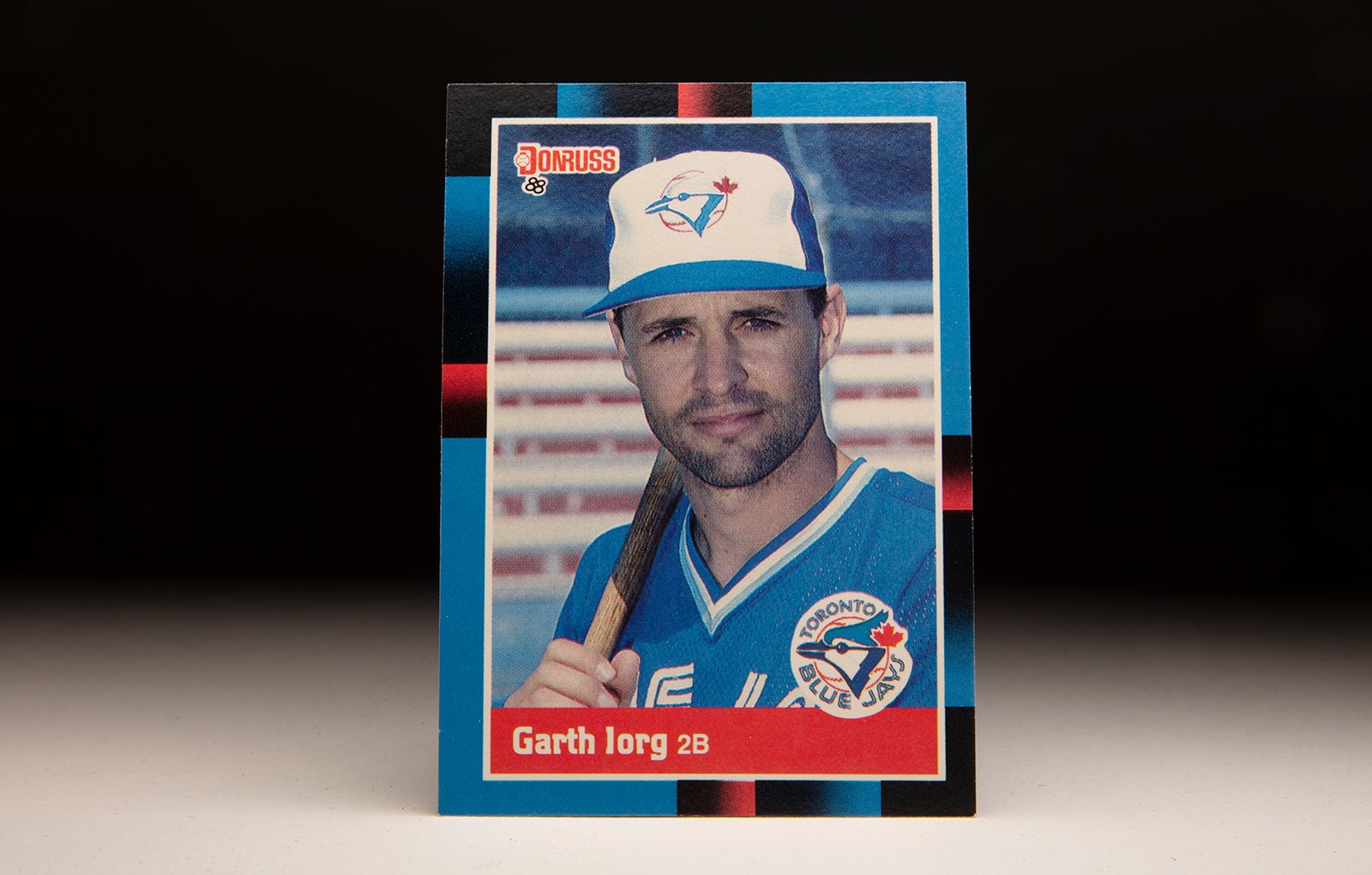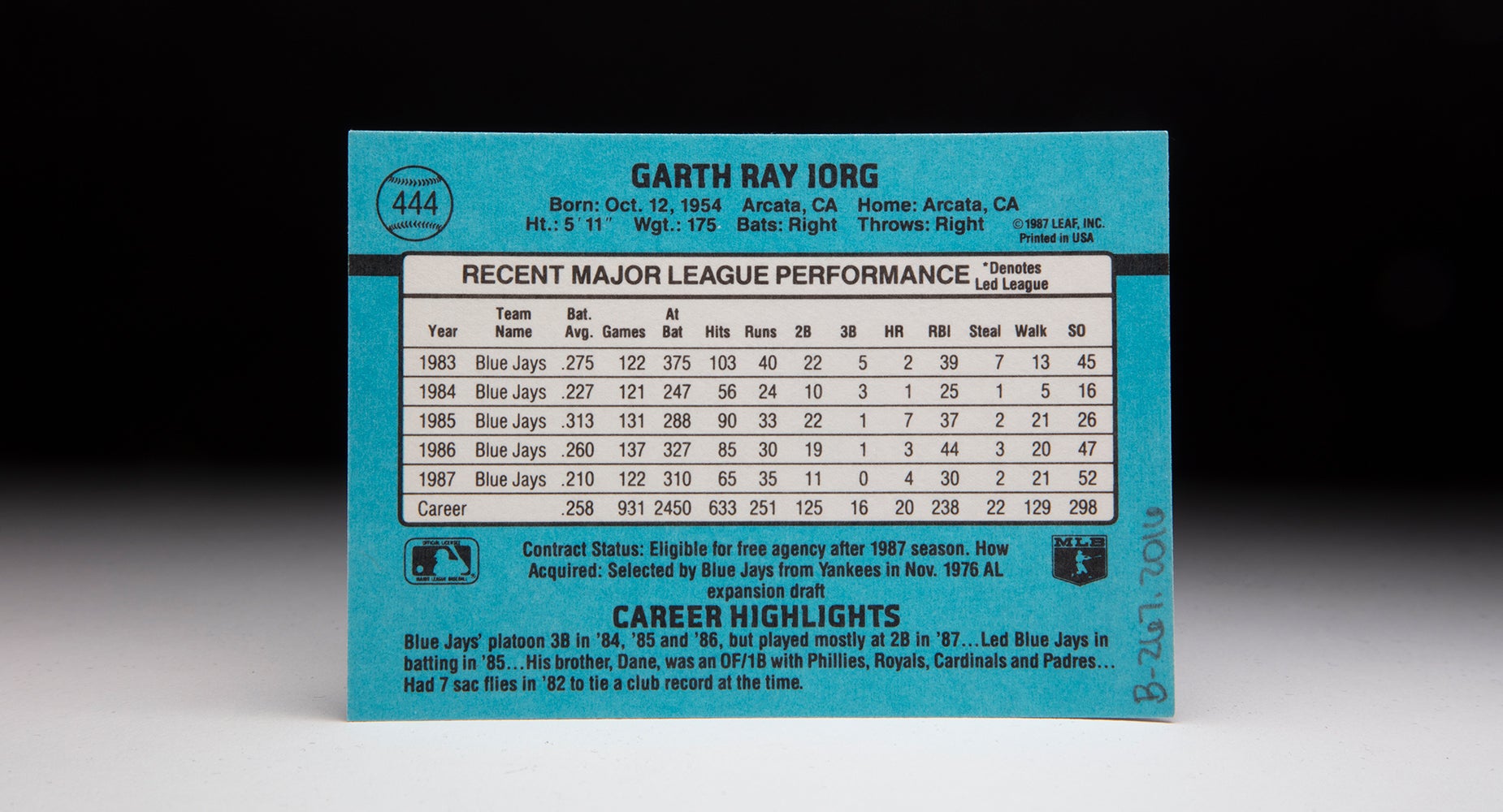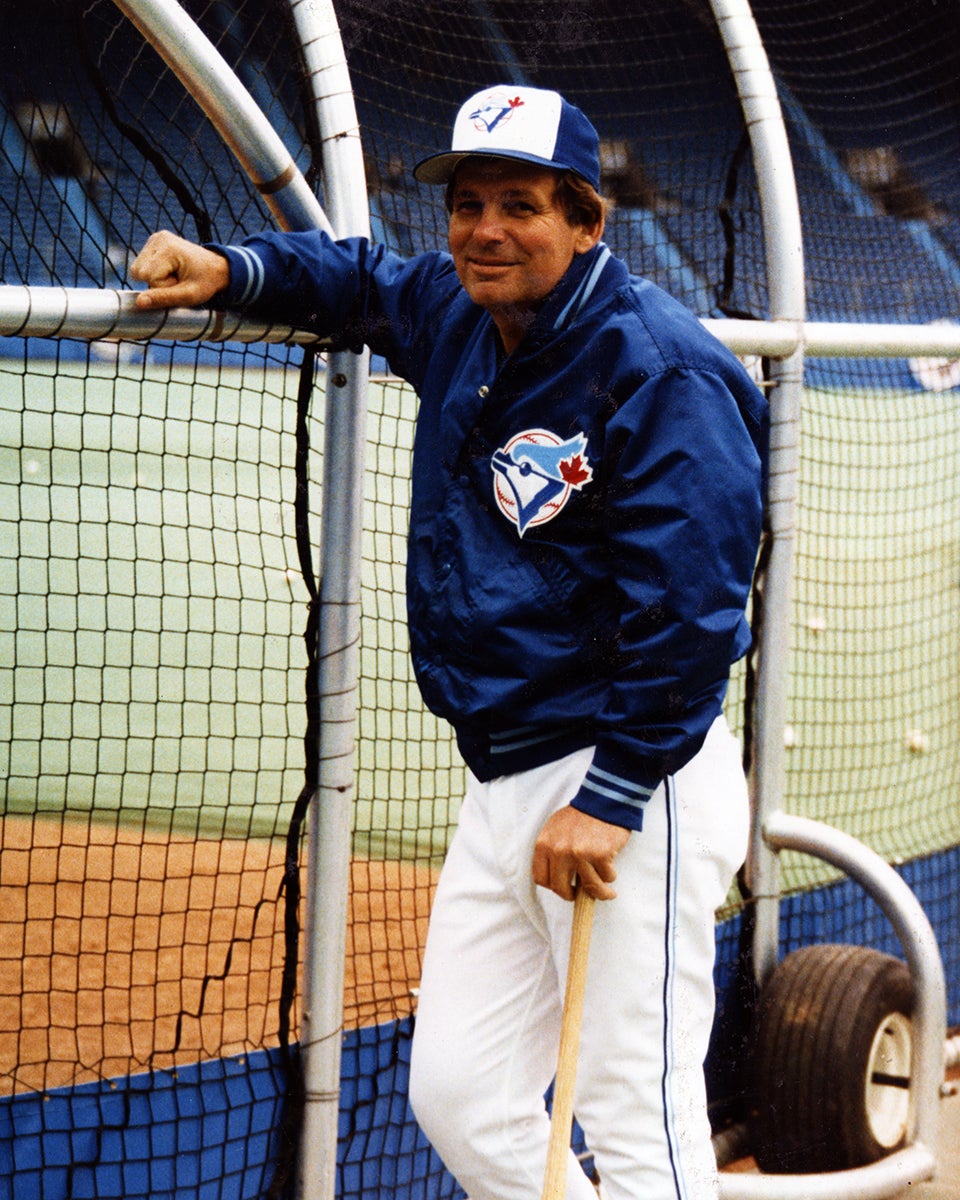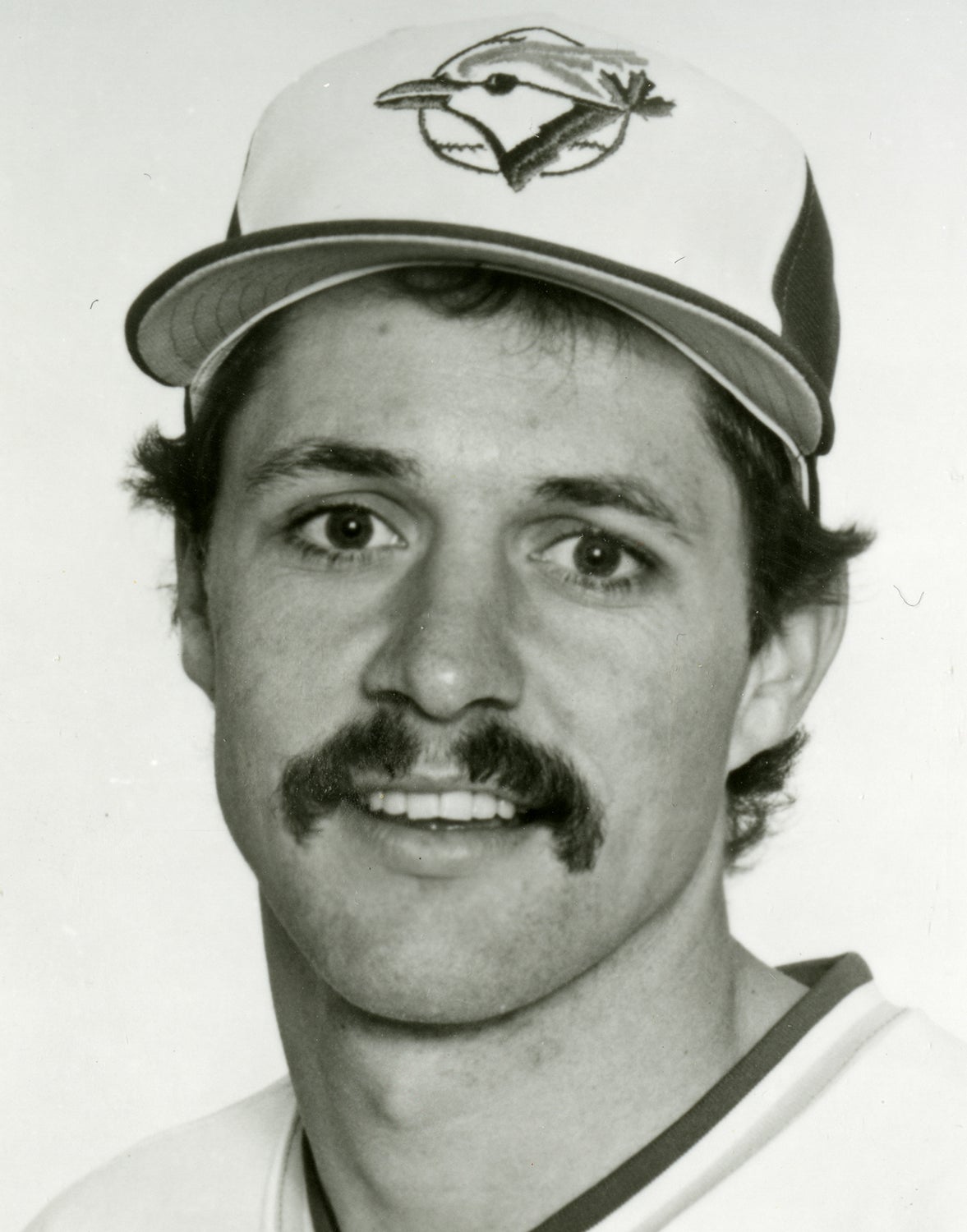- Home
- Our Stories
- #CardCorner: 1988 Donruss Garth Iorg
#CardCorner: 1988 Donruss Garth Iorg
If name recognition is equivalent to immortality in baseball, Garth Iorg may be among the most famous players in history.
Two players in baseball annals have had the first name of Garth – and one was Garth Mann, whose entire MLB career consisted of a single-game pinch-running appearance for the Cubs on May 14, 1944.
Garth Iorg, meanwhile, is one of only two players named “Iorg” to appear in a big league game – the other being his brother, Dane.
Over the course of his nine seasons with the Blue Jays, however, Garth Iorg was much more than a unique surname on the back of a Blue Jays jersey.

Garth Ray Iorg was born Oct. 12, 1954, in Arcata, Calif., and grew up in nearby Blue Lake – a town about 10 miles inland from the Pacific Ocean in Northern California. His father, Charlie, worked at a sawmill for most of his adult life, milling redwoods.
A three-sport star at Arcata High School who often turned up in headlines for his basketball prowess, Iorg graduated in 1973 and was selected in the eighth round of the 1973 MLB Draft as a shortstop by the Yankees. Hailing from a Mormon background, he turned down a combination baseball/basketball scholarship to Brigham Young University and signed with New York.
His brother Dane would eventually make the big leagues, and another older brother, Lee, would get as high as Triple-A with the Mets.
“I was a Little League coach for what must have been 15 years,” Charlie Iorg told the Boston Globe during the 1985 ALCS when Garth played for the Blue Jays and Dane for the Royals. “I coached all my sons. Lee was a center fielder. He could really go get ’em. Dane, he was always the hitter. Garth, the baby, (was) always the good infielder.”
But even after signing and hitting .273 for Johnson City of the Appalachian League in 51 games in the summer of 1973, Garth Iorg enrolled at College of the Redwoods in Eureka, Calif., to pursue basketball and scored more than 600 points during his career with the Corsairs.
“I looked up to both my brothers all the time,” Iorg told the St. Louis Post-Dispatch in the spring of 1981. “I thought maybe someday I could be just like them. They seemed bigger than life.”
Iorg moved up to Class A Fort Lauderdale in 1974 and hit .215 in 102 games before splitting the 1975 season between Fort Lauderdale and Double-A West Haven of the Eastern League, batting a combined .251 with 22 stolen bases in 126 games. In 1976, Iorg was hitting .275 through 78 games with West Haven when a broken left leg ended his season. Then, on Nov. 5, Iorg was selected by the Blue Jays with the 41st pick in the Expansion Draft.
“He was having a good year last year when he broke his leg,” Charles Iorg told the Times Standard of Eureka on the day his son was selected by the Blue Jays. “That’s the reason (the Yankees) took him to winter ball. They wanted him to work on the weights and get him back in shape.”

Iorg played in Venezuela that winter and then reported to the Blue Jays’ inaugural Spring Training camp in Dunedin, Fla. He was still regaining strength in his left leg and had lost some of his previous speed. But the Blue Jays sent him to Triple-A Charleston of the International League with the promise that he would play every day. After hitting .294 for the Charlies, Iorg was among Toronto’s September call-ups but he did not get into any games.
After a solid spring in 1978, Iorg started the Blue Jays’ third game of the season at second base when Opening Day starter Dave McKay – who, after starting at third base on Opening Day in the first-ever Blue Jays game in 1977 and was the only player to start again in the 1978 opener – was sidelined. Iorg started a total of 14 games in April but was hitting only .186 at the end of the month as McKay received more and more playing time.
In May, the Blue Jays optioned Iorg to Triple-A Syracuse where he spent the rest of the season, hitting .216 in 89 games with the Chiefs. In November, the Blue Jays outrighted Iorg off their 40-man roster.
But in 1979, Iorg rebuilt his prospect status by hitting .281 with 23 doubles in 121 games for Syracuse. He did not appear in a game for the Blue Jays that year but no one took a strong hold of the second base job for Toronto, as McKay played most of the season for Syracuse while future NBA star Danny Ainge received the majority of the innings at second for Toronto.
Iorg’s bases-loaded walk-off walk in the 13th inning gave Syracuse a 5-4 win against Columbus in Game 3 of the International League’s Governors’ Cup finals against Columbus, a series Iorg and the Chiefs ultimately lost in seven games.
Iorg began the 1980 season back in Syracuse, where he hit .299 in 32 games before being recalled to Toronto in May when injuries hit the Blue Jays’ infield and Ainge was sent back to Triple-A. Iorg saw regular playing time the rest of the season – seeing action at second base, third base and left field – and finished the year hitting .248 in 80 games with Toronto.
“I think I’ve proved I can play every day,” Iorg told the Canadian Press, “and for a lot of teams in this league.”
Iorg began the 1981 season on the Blue Jays roster, marking the first time that he and Dane – an outfielder with the Cardinals – had simultaneously opened the season in the big leagues.
“There’s tons of guys in the minor leagues in the same situation that I’ve been in,” Garth Iorg told the St. Louis Post-Dispatch of his struggle to stick in the majors. “For me, it’s not a family thing so much as I like baseball. It’s as simple as that: I like playing baseball.”
Iorg backed up second baseman Dámaso García and shortstop Alfredo Griffin for much of the 1981 season, earning regular playing time at second base in September after García was injured. Iorg finished the year batting .242 in 70 games.
Then on March 25, 1982, the Blue Jays acquired lefty-hitting infielder Rance Mulliniks in exchange for pitcher Phil Huffman. A week later, Toronto traded veteran third baseman Aurelio Rodríguez – who they had acquired in the offseason – to the White Sox for Wayne Nordhagen, leaving Mulliniks as the most viable option at third base. But Blue Jays manager Bobby Cox had something else in mind.

Mulliniks started at third base on Opening Day against Milwaukee right-hander Pete Vuckovich and Iorg followed at third the day after against lefty Mike Caldwell, creating a platoon setup that would last for most of the next six seasons.
“I have always been a utility man but now I am at least semi-fulltime,” Iorg told United Press International. “This makes coming to the park so much different. When you are sitting on the bench and see a left-hander coming to the mound, you know you are going to play. It’s fun.”
Iorg hit .285 in 129 games in 1982 with 20 doubles and five triples while Mulliniks batted .244. But starting in 1983, Mulliniks became one of the most respected under-the-radar hitters in the game – averaging .293 with a .374 on-base percentage to go with 25 doubles a year from 1983-88.
“It started working right from day one,” Cox told UPI of his third base platoon. “Both are good defensively, are good clutch hitters and are excellent at moving runners along. Somebody’s going to have to beat them out (to change the platoon), and nobody’s shown any indication of that yet.”
Iorg was nearly Mulliniks’ twin, consistently holding up his half of the platoon. Meanwhile, Dane Iorg grabbed national headlines during the 1982 World Series as the Cardinals’ designated hitter, hitting .529 with four doubles and a triple in five games as St. Louis defeated the Brewers in seven games.
Suddenly, the Iorg brothers were the talk of baseball.
“The most important thing is production,” Mulliniks told UPI. “As long as Garth and I produce, you’d have to think they’d keep things the way they are.”
Iorg batted .275 in 122 games in 1983 as Toronto posted its first winning season (89-73) in franchise history. He slumped to .227 in 1984 but bounced back with the best campaign of his career in 1985, hitting .313 with 22 doubles and seven home runs as the Blue Jays won the American League East.

Facing a Royals team that featured lefty starters Charlie Leibrandt, Danny Jackson and Bud Black in the ALCS, Iorg started four of the first five games of the series and appeared in six of seven. He hit .133 and was held without an extra base hit or RBI as Kansas City advanced to the World Series.
With two on and two outs in the bottom of the ninth of Game 6 and the Royals clinging to a 5-3 lead, manager Dick Hower brought relief ace Dan Quisenberry on to face Iorg. Quisenberry, who struck out just 3.3 batters per nine innings pitched over his 12-year career, fanned Iorg on a 1-2 pitch to end the game.
“You can’t think about previous things,” Quisenberry, who gave up two game-winning hits earlier in the ALCS, told the Associated Press about his battle with Iorg. “You have to work those things out of your system.”
Meanwhile, Dane Iorg, a reserve for the Royals, had a hit and two walks in four plate appearances in the ALCS. Then in the World Series, Dane’s two-run, two-out, pinch-hit single in the bottom of the ninth of Game 6 gave Kansas City a 2-1 win and sent the series to Game 7, where the Royals won their first title.
Cox moved on after the 1985 season, returning to the Braves – where he had managed from 1978-81 – as the team’s general manager. Jimy Williams took over for Cox Iorg hit .260 in a career-best 137 games. But the platoon system that had worked so well for so long was ending, as the Blue Jays worked top prospect Kelly Gruber into the lineup at third base.
In 1987, Gruber became the regular third baseman and Iorg moved back to second base, hitting .210 as Toronto led the AL East for much of the season before the Tigers passed them for the title during the final weekend. With Gruber in a slump, Williams started Iorg at third base in the season’s final game – a must-win for Toronto – but Iorg went 0-for-4 in the Blue Jays’ 1-0 loss that gave the Tigers the title. Iorg made the final out of the game, grounding to pitcher Frank Tanana.

“I remember Garth Iorg tapped back to the mound for the last out,” Tigers manager Sparky Anderson told the Canadian Press in 1989. “My heart was in my fanny.”
A free agent after the 1987 season, Iorg found no offers and did not play in organized baseball in 1988. He returned to action, however, in the Senior Professional Baseball Association in the fall of 1989 in his last games as a professional.
Iorg soon went into coaching and began managing in the Blue Jays farm system. He made it back to the big leagues in 2008 as a Milwaukee Brewers coach and was the team’s first base coach from 2011-14.
In nine seasons in the big leagues – all with Toronto – Iorg hit .258 with 125 doubles and 251 runs scored in 931 games. And though he was done playing by the time the Blue Jays won their first World Series title in 1992, Iorg was undoubtedly part of the group of players that laid the foundation for greatness in Toronto.
“I am confident in my ability,” Iorg told the St. Petersburg Times in the spring of 1981. “You have to (play) with the idea of doing the best job you are capable of.”
Craig Muder is the director of communications for the National Baseball Hall of Fame and Museum
